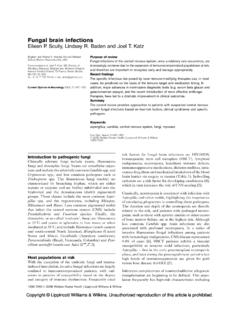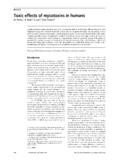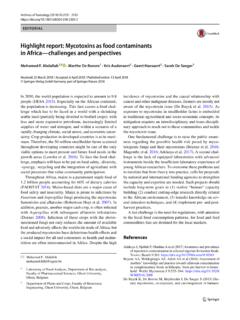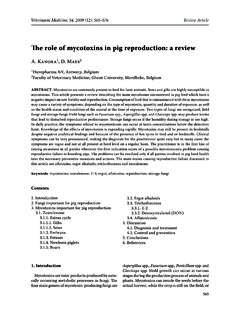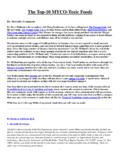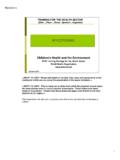Transcription of Physician Educational: The Fungus Link and …
1 Dear Doctor,Your patient has requested information on an antifungal protocol. I was a US Navy hospital corpsman, trained in emergency medicine and served in that capacity while attached to the 7th Marine Division in Vietnam. Upon returning home, I su ered from numerous symptoms. For years I attributed those to PTSD. Dr. Everett Hughes, with whom I was collaborating on research with at USC Medical School, suggested that, given my overseas deployment, perhaps my symptoms were due to a parasite. While studying parasitology, I discover that pathogenic fungi parasitize humans. Upon doing so, hosts often begin eating a carbohydrate rich diet to satisfy the fungal parasites cravings.
2 Fungal secondary metabolites, mycotoxins, are commonly found in our American grain and peanuts supply and serve as a portal of entry. I developed a highly nutritional, yet carbohydrate-sparing diet in the 1970 s that works wonderfully to starve fungi. Many have maintained this diet for over a decade, so it is quite safe. The diet is dispensed freely to everyone on my website, , a website developed to teach the lay public about pathogenic fungi, their mycotoxins and systemic fungal infections. This diet is the genesis of the antifungal August 2017, the CDC published that certain less common fungi infections (Valley Fever and Candidemia) can cause serious illness and even death.
3 Further, in addition to other factors, the CDC published that taking taking certain medications increased vulnerability to serious fungal infections. Fungal diseases, they wrote, are not diagnosed right away, because fungal symptoms can mimic other diseases. Finally, they apprised the general public to think Fungus when their symptoms persist despite medical treatment. The CDC recommended that your patients talk to you about the possibility of a fungal infection. (1) There are currently 610 papers on highlighting the ability of fungal mycotoxins to induce genetic mutations. Mycotoxins are secondary metabolites produced by micro fungi that are capable of causing disease and death in humans and other animals.
4 (2) Exposure to mycotoxins is thought to be common,as our corn and groundnut supply, often contaminated with mycotoxins, is both plentiful and regularly consumed. Dietary exposure to Aspergillus mold is known as a hepatocellular carcinoma human risk factor. (3)Parasitic fungi can thrive in a symbiotic relationship with its host, but they can also become obligates, in which case they can feed at the expense of a host. At this point a patient can begin experiencing annoying or more severe symptoms. Unfortunately, diagnosing fungal disorders remains di cult and time consuming. For this reason, the short protocol outlined in this brief letter may assist many patients improve dramatically within 14 days on the antifungal diet alone, sometime simply starving fungi is not always enough.
5 For this reason, some of the physicians that I have consulted with, also use short-term gut and systemic antifungal therapy simultaneously. The diet and antifungal drug protocol enabled the Physician to quickly and safely rule out, or diagnose a fungal condition. The antifungal drug protocol we have used for several years proved to be safe and e cacious, as we never once observed hepatotoxicity, or any other adverse drug event, while on this short-term antifungal drug & Antifungal Drug ProtocolPhysician Educational: The Fungus Link and Prescribing Antifungal MedicationsNystatin 500,000 tabs #180 Sig: i po bid pc X 3d, thereafter ii po bid pc1 re llFluconazole 200mg #14 Sig: tab po qd X 2d, thereafter one po qod1 re llItraconazole, or Sporanox, has recently made news.
6 In that it has been repurposed as a cancer chemotherapy drug (4). In lieu of using Di ucan, some practitioners o er Sporanox to their patients. Given the rise in both cancer cases and Aspergillus induced fungal infections, this may be a good option for a short-term trial. For suspected Aspergillosis infections, 1-2 caps daily is recommended, as opposed to suspected Blastomycosis and Histoplasmosis infections, wherein 2 caps daily are 200mg #30 Sig: i-ii po pc re llI have worked with many physicians in the past 4 decades and developed working models for the inclusion of antifungal programs in their practices. Most importantly, upon our follow up visits with each patient in 14 days, we observed results like we never had before.
7 At that point, we terminated antifungal drugs in favor of antifungal supplements like Vitamin C, Vitamin D3, Caprylic Acid or Resveratrol, although some opted for routine liver tests and continuation on the antifungal drugs, given their newfound relief. Patients loved the results and the fact that we enabled them more control of their fungal symptoms. Many had nally achieved a diagnosis, an easy to follow antifungal protocol and hope. They referred many new patients to I may be of further assistance to you, please don t hesitate to contact me, personally, M-F, at Sincerely,Doug A. Kaufmann(1). Announcement: Fungal Diseases Awareness Week August 14-18, 2017.
8 MMWR morbidity and mortality Weekly, Rep 2017;66:837(2). Clin. Microbiol. Rev. July 2003 vol. 16 no. 3 497-516 (3). J Gastrointestin Liver Dis. 2013 Sep;22(3):305-10 (4). Ecancermedicalscience. 2015; 9: 521
